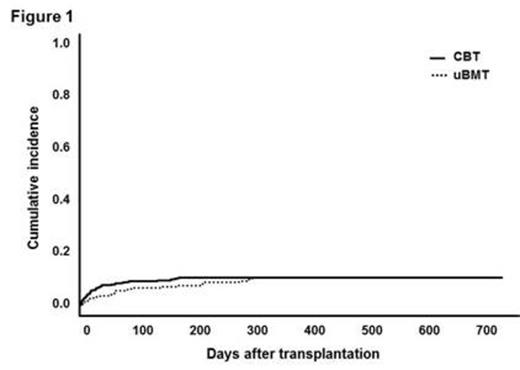Invasive fungal infections (IFIs) are of great concern after allogeneic hematopoietic stem cell transplantation (HSCT), the risk of which is considered to be particularly prominent among cord blood transplantation (CBT) recipients.
We retrospectively analysed the records of 749 adult patients who underwent CBT or unrelated bone marrow transplantation (uBMT) for the first time at the Toranomon Hospital between 2002 and 2012, and who had neither prior history nor suspicious findings of IFIs. As prophylaxis for IFIs, fluconazole (FLCZ) or itraconazole (ITCZ) capsules were conventionally used until around 2006, which were then changed to newer mold-active agents including ITCZ oral solution, voriconazole or micafungin after their approval in Japan, the choice of which was subjected to physician's discretion.
Engraftment achieved in 418 CBT patients and 198 uBMT patients with a significantly longer neutropenic period in CBT patients (median 20 days vs 18 days, P<0.001), whereas 37 patients underwent re-transplantation and 96 died before engraftment. The incidences of grade II-IV acute graft-versus-host disease (GVHD) and extensive chronic GVHD were significantly less frequent after CBT compared to uBMT (40% vs 54% and 17% vs 46%, both P<0.001). Systemic corticosteroids at ≥0.5mg/kg/day was given in fewer CBT patients compared to uBMT patients (59% vs 66%, P=0.07). The median durations of immunosuppressants and antifungal prophylaxis were significantly shorter in CBT patients compared to uBMT patients (118 days vs 302 days and 315 days vs 491 days, both P<0.001). As prophylaxis for IFIs, 194 CBT patients and 91 uBMT patients received FLCZ/ITCZ capsules, while 341 CBT patients and 123 uBMT patients received newer mold-active agents. Seventy-nine patients (57 in CBT and 22 in uBMT) developed IFIs with a cumulative incidence of 12.2%, at a median of 27 (1-1646) days after HSCT. About 60% of the patients developed IFIs by day 50 and the percentage reached more than 90% until 1 year. The median onset was significantly earlier in CBT patients compared to uBMT patients (day 19 vs day 61, P=0.007). The cumulative incidence of IFIs was significantly higher in CBT patients compared to uBMT patients during 50 days after HSCT (7.9% vs 3.8%, P=0.04), but became significantly lower thereafter until 1 year (2.7% vs 6.9%, P=0.02), and an overall incidence was almost similar between the 2 groups (12.6% vs 11.6%, P=0.58) (Figure 1).
Four patients had 2 infectious episodes caused by different fungal species, and a total of 83 infectious episodes were documented. Eighty-one cases were breakthrough infection during antifungal prophylaxis (FLCZ/ITCZ capsules in 28, and newer mold-active agents in 53). Invasive aspergillosis (IA) was the most common, accounting for 67.9% (proven in 11, probable in 46), followed by invasive candidiasis (IC), (19.3%; candidemia in 15, encephalitis in 1). Although the incidences of IA and IC were comparable between CBT and uBMT patients, relatively rare type of IFIs caused by Trichosporon (4 cases), Mucor (2 cases) and Rodotorula (1 case) exclusively occurred in CBT patients, except one case of Fusarium infection in a patient who relapsed after uBMT.
Grade II-IV acute GVHD, extensive chronic GVHD and systemic corticosteroids at ≥0.5mg/kg/day were identified as significant risk factors of IFIs for both groups (HR 1.89, P=0.01, HR 4.16, P=0.006, and HR 1.83, P=0.02). However, the impact of all these were not apparent in CBT patients (HR 1.59, P=0.16, HR 2.18, P=0.29 and HR 1.48, P=0.22), in contrast with the powerful impact in uBMT patients (HR 2.51, P=0.049, HR 10.23, P=0.03 and HR 2.87, P=0.03). Although the cessation of antifungal prophylaxis significantly increased the risk of IFIs in uBMT patients (HR 5.95, P=0.01), it showed no impact in CBT patients (HR 0.87, P=0.89). IFIs were main causes of death in 21 patients, which significantly affected non-relapse mortality in both CBT and uBMT patients (HR 3.93 and HR 6.08, both P<0.001).
Unrelated cord blood did not increase an overall incidence of IFIs, because higher risk in the early post-transplant period was counterbalanced by the dramatically decreased risk due to lower frequencies of GVHD and its treatment in the later period. Particular attention might be required to the early-onset IFIs due to fungi other than Aspergillus or Candida species, in order to further decrease the risk of IFIs after CBT.
No relevant conflicts of interest to declare.


This feature is available to Subscribers Only
Sign In or Create an Account Close Modal